Differences in Port Pricing Strategies: Case of Port and Fairway Fees in Northern Baltic Sea Countries
Abstract
1. Introduction
- What are the port and fairway fees in the case countries with selected vessels?
- How are the port and fairway fees structured in the case countries?
- Is there a general structure of the port and fairway fees used by the countries?
2. Literature Review: Basis of the Port Fees
2.1. Port Pricing Policies
- Cost-based pricing—based on the cost of products or services plus adding a profit margin.
- Performance-based pricing—based on the utilization of the facility above or below the optimum level with the objective of efficient use of the facility, e.g., berth utilization.
- Value-based pricing—products and services are priced on their perceived value to the customer. Cargo groups with different price elasticities are charged differently based on the value of service. This strategy allows the port to promote specific market segments.
- Competition-based pricing—based on competitors’ expected or observed price levels.
- Strategic port pricing or market-based pricing—expected market demand is the base for port tariffs.
2.2. Components of Port Fees and Charges
2.3. Complexity of Environment-Based Port Dues
3. Port Pricing in Case Ports
3.1. Structure of the Port Fees
{(Waste management fee rate × vessel GT) + (no. of mooring operations × vessel GT range) + (Passenger fee rate × no. of fee eligible
passengers) + (Cargo fee rate × cargo amount) + ∑[no. of pilotage operations × (vessel GT range, pilotage in port + distance)] +
(Fairway fee rate × vessel GT)} × no. of calls
3.2. Calculation of Port Fees
3.3. Comparison of Port Fees
4. Discussion
Author Contributions
Funding
Institutional Review Board Statement
Informed Consent Statement
Data Availability Statement
Conflicts of Interest
Abbreviations
| CSI | Clean Shipping Index |
| DWT | Deadweight |
| EMDE | Estonian Electronic Maritime Information System |
| ESI | Environmental Ship Index |
| EU | European Union |
| EUR | Euro |
| GT | Gross Tonnage |
| IMO | International Maritime Organisation |
| NT | Net Tonnage |
| lm | Lane Meter |
| LNG | Liquified Natural Gas |
| m | Metre (UK)/meter (US) |
| mln | Million |
| RGT | Reduced Gross Tonnage |
| ro-ro | Roll on-roll off |
| TEU | Twenty Foot Equivalent Unit |
| UN | United Nations |
| VTS | Vessel Traffic Services |
References
- Notteboom, T.; Pallis, A.; Rodrigue, J.-P. Port Economics, Management and Policy, 1st ed.; Routledge: London, UK, 2022; Available online: https://www.taylorfrancis.com/books/mono/10.4324/9780429318184/port-economics-management-policy-theo-notteboom-athanasios-pallis-jean-paul-rodrigue (accessed on 25 March 2024).
- FINLEX. Ajantasainen Lainsäädäntö: Laki Väylävirastosta 862/2009; Oikeusministeriö; Lakitieto Oy Ed.; Finlex: Glenelg, Australia, 2009; Available online: https://finlex.fi/fi/laki/ajantasa/2009/20090862 (accessed on 7 February 2025).
- Transpordiameti Põhimäärus–Riigi Teataja. Available online: https://www.riigiteataja.ee/akt/109122020001?leiaKehtiv (accessed on 7 February 2025).
- Geerts, M.; Dooms, M.; Langenus, M. Green Pricing Decision-Making: Tackling Uncertainty in the Case of Port Infrastructure. In Port Management; Pettit, S., Beresford, A., Eds.; Kogan Page: London, UK, 2018; pp. 207–244. ISBN 978-0-7494-7432-4. [Google Scholar]
- Acciaro, M. Environmental Pricing in Ports. In Proceedings of the Annual Conference of the International Association of Maritime Economists. IAME 2023, Long Beach, CA, USA, 5–8 September 2023. [Google Scholar]
- Talley, W.K.; Ng, M. Maritime transport chain choice by carriers, ports and shippers. Int. J. Prod. Econ. 2013, 142, 311–316. [Google Scholar] [CrossRef]
- Martínez-López, A.; Romero-Filgueira, A.; Chica, M. Specific environmental charges to boost Cold Ironing use in the European Short Sea Shipping. Transp. Res. Part D Transp. Environ. 2021, 94, 102775. [Google Scholar] [CrossRef]
- Bergqvist, R.; Egels-Zandén, N. Green port dues—The case of hinterland transport. Res. Transp. Bus. Manag. 2012, 5, 85–91. [Google Scholar] [CrossRef]
- Maritime Safety Act–Riigi Teataja. Available online: https://www.riigiteataja.ee/en/eli/ee/504072023003/consolide/current (accessed on 17 March 2025).
- Maritime Safety Act–Riigi Teataja. Available online: https://www.riigiteataja.ee/en/eli/511012024001/consolide (accessed on 5 April 2024).
- Sootla, G.; Kalev, L.; Kattai, K. (Eds.) Avalik Poliitika. I, Avaliku Poliitika Kujundamise Protsess; TLÜ Kirjastus: Tallinn, Estonia, 2021; Available online: https://www.digar.ee/arhiiv/nlib-digar:994949 (accessed on 7 February 2025).
- Parliament of Estonia Riigi. Aasta Lisaeelarve Seadusega Seonduvate Seaduste Muutmise Seadus (COVID-19 Haigust Põhjustava Koroonaviiruse Levikuga Seotud Meetmed) 169 SE. 2020. Available online: https://www.riigikogu.ee/tegevus/eelnoud/eelnou/cad9e912-b0d8-428d-be1f-b14e22ed5ecd/riigi-2020.-aasta-lisaeelarve-seadusega-seonduvate-seaduste-muutmise-seadus-covid-19-haigust-pohjustava-koroonaviiruse-levikuga-seotud-meetmed/ (accessed on 3 February 2025).
- Haralambides, H.E. Competition, Excess Capacity, and the Pricing of Port Infrastructure. Int. J. Marit. Econ. 2002, 4, 323–347. [Google Scholar] [CrossRef]
- Tapaninen, U. Maritime Transport Shipping Logistics and Operations; Kogan Page: London, UK, 2020. [Google Scholar]
- Meyiwa, A.; Chasomeris, M. South Africa’s port dOctoberrine: Dilemmas and the way forward. Marit. Stud. 2020, 19, 179–191. [Google Scholar] [CrossRef]
- Haralambides, H.; Musso, E.; Benacchio, M. Port Financing and Pricing in the European Union: Theory, Politics and Reality. Marit. Econ. Logist. 2001, 3, 368–386. [Google Scholar] [CrossRef]
- Mthembu, S.E.; Chasomeris, M. Revisiting Marine services pricing in South Africa’s ports. WMU J. Marit. Aff. 2024, 23, 5–24. [Google Scholar] [CrossRef]
- Van Den Berg, R.; De Langen, P.W.; Van Zuijlen, P.C.J. Revisiting port pricing; a proposal for seven port pricing principles. WMU J. Marit. Aff. 2017, 16, 421–438. [Google Scholar] [CrossRef]
- Acciaro, M. A Critical Review of Port Pricing Literature: What Role for Academic Research? Asian J. Shipp. Logist. 2013, 29, 207–228. [Google Scholar] [CrossRef]
- Comparative Analysis of Port Tariffs in the ESCAP Region. 2002. Available online: https://hdl.handle.net/20.500.12870/2916 (accessed on 13 June 2024).
- Hinterhuber, A. Customer value-based pricing strategies: Why companies resist. J. Bus. Strategy 2008, 29, 41–50. [Google Scholar] [CrossRef]
- Lavissiere, A. Vessel Port Dues: An Influence from Path Dependency rather than Geography of Ports. Asian J. Shipp. Logist. 2018, 34, 61–70. [Google Scholar] [CrossRef]
- Eidast, A. Meretranspordi Kommertsekspluatatsioon; Eesti Mereakadeemia: Tallinn, Estonia, 2007. [Google Scholar]
- European Union. Directive (EU) 2019/883 of the European Parliament and of the Council of 17 April 2019 on Port Reception Facilities for the Delivery of Waste from Ships, Amending Directive 2010/65/EU and Repealing Directive 2000/59/EC (Text with EEA Relevance); European Union: Brussels, Belgium, 2019; Volume 151, Available online: http://data.europa.eu/eli/dir/2019/883/oj/eng (accessed on 2 December 2022).
- Port Fees and Rules—Freeport of Ventspils Authority. Available online: https://www.portofventspils.lv/en/port-services/port-fees-and-rules/ (accessed on 10 October 2022).
- Merkel, A.; Lindgren, S. Effects of fairway dues on the deployment and utilization of vessels: Lessons from a regression discontinuity design. Transp. Policy 2022, 126, 204–214. [Google Scholar] [CrossRef]
- Mjelde, A.; Endresen, Ø.; Bjørshol, E.; Gierløff, C.W.; Husby, E.; Solheim, J.; Mjøs, N.; Eide, M.S. Differentiating on port fees to accelerate the green Maritime transition. Mar. Pollut. Bull. 2019, 149, 110561. [Google Scholar] [CrossRef] [PubMed]
- Lindé, T.; Vierth, I.; Cullinane, K. Evaluating the effects of Sweden’s environmentally differentiated fairway dues. Transp. Res. Part D Transp. Environ. 2019, 70, 77–93. [Google Scholar] [CrossRef]
- Parsmo, R.; Ytreberg, E.; Verdaasdonk, M.; Fridell, E. Environmental discounts for Swedish ports and fairways: A ship owner perspective. Mar. Policy 2024, 159, 105950. [Google Scholar] [CrossRef]
- Port Dues. Freeport of Riga Authority. Available online: https://rop.lv/en/port-dues (accessed on 10 October 2022).
- Cabinet of Ministers of the Republic of Latvia. Information Regarding Navigation Due for Vessels Entering Latvian Ports. 2021. Available online: https://www.lja.lv/sites/default/files/pricelist_attachments/Navigation_due_2022.docx (accessed on 5 December 2022).
- Port of Helsinki. Price List 2022, Helsinki 2021. 2021. Available online: https://www.portofhelsinki.fi/sites/default/files/attachments/Price%20List%202022_0.pdf (accessed on 8 September 2022).
- Port of Helsinki. Additional Information and Implementation Guidelines Concerning the Environmental Discount 2022. 2021. Available online: https://www.portofhelsinki.fi/sites/default/files/attachments/Additional%20information%20and%20implementation%20guidelines%20concerning%20the%20environmental%20discount%20_2022.pdf (accessed on 8 September 2022).
- Tulli. Fairway Dues—Finnish Customs. Available online: https://tulli.fi/en/frontpage?p_p_id=fi_yja_language_version_tool_web_portlet_LanguageVersionToolMissingNotificationPortlet&_fi_yja_language_version_tool_web_portlet_LanguageVersionToolMissingNotificationPortlet_missingLanguageVersion=1 (accessed on 12 October 2022).
- Finnpilot. Pilotage Fees. Available online: https://finnpilot.fi/en/for-customers/pilotage-fees/ (accessed on 12 November 2022).
- Prices for Services/Tariffs—Portsofstockholm.com. Available online: https://www.portsofstockholm.com/about-us/prices-for-servicestariffs/ (accessed on 16 September 2022).
- The Swedish Maritime Administration’s Shipping due Model. Available online: https://www.sjofartsverket.se/contentassets/ac04e861247b4019a9c0a9ea848904f3/price-list-2022_eng.pdf (accessed on 16 July 2024).
- The Swedish Maritime Administration’s Regulations on the Provision of Pilots, Pilot Orders, the Allocation of Pilots and Pilot Fees. Available online: https://www.sjofartsverket.se/globalassets/om-sjofartsverket/lagrum/oversatta-forfattningar/sjofartsverkets-foreskrifter-sjofs-2022-2-om-tillhandahallande-av-lots-lotsbestallning-tilldelning-av-lots-och-lotsavgifter---english-version.pdf (accessed on 16 July 2024).
- Dues and Fees. Available online: https://www.sjofartsverket.se/en/about-us/about-the-swedish-Maritime-administration/dues-and-fees/#fairway-dues (accessed on 3 July 2024).
- Lootsitasud—Eesti Loots. Available online: https://www.loots.ee/lootsitasud/ (accessed on 10 October 2022).
- Port of Tallinn. Port Charges and Fees. Available online: https://www.ts.ee/wp-content/uploads/2022/05/Sadamatasud_al_01_05_2022_inglise_keelne-1.pdf (accessed on 16 July 2024).
- Port of Sillamäe. Port Dues and Charges. Available online: https://www.silport.ee/silport_port_fees.pdf?rand=3 (accessed on 16 July 2024).
- Maritime Safety Act–Riigi Teataja. Available online: https://www.riigiteataja.ee/en/eli/ee/520122021001/consolide (accessed on 28 September 2022).
- European Union. Commission Implementing Regulation (EU) 2022/91 of 21 JANUARY 2022 Defining the Criteria for Determining that a Ship Produces Reduced Quantities of Waste and Manages Its Waste in a Sustainable and Environmentally Sound Manner in Accordance with Directive (EU) 2019/883 of the European Parliament and of the Council (Text with EEA Relevance); European Union: Brussels, Belgium, 2022; Volume 15, Available online: http://data.europa.eu/eli/reg_impl/2022/91/oj/eng (accessed on 2 December 2022).
- ABS: American Bureau of Shipping. Available online: https://absrecord.eagle.org/#/absrecord/details (accessed on 21 June 2024).
- DNV Vessel Register. Available online: https://vesselregister.dnv.com/vesselregister/details/32300 (accessed on 21 June 2024).
- DNV Vessel Register. Available online: https://vesselregister.dnv.com/vesselregister/details/23655 (accessed on 21 June 2024).
- DNV Vessel Register. Available online: https://vesselregister.dnv.com/vesselregister/details/G113538 (accessed on 21 June 2024).
- DNV Vessel Register. Available online: https://vesselregister.dnv.com/vesselregister/details/31618 (accessed on 21 June 2024).
- Fleet. Available online: https://www.hansashipping.ee/fleet (accessed on 21 June 2024).
- Megastar—Tallink Silja Line. Available online: https://www.tallink.com/on-board/fleet/megastar (accessed on 21 June 2024).
- Electronic Maritime Information System/Transpordiamet. Available online: https://www.emde.ee/pm5052/vi- (accessed on 6 August 2022).
- Tapaninen, U.; Palu, R. Recovery of ro-pax ferry traffic from covid-19 under tightening environmental regulations: Case Helsinki-Tallinn. J. Shipp. Trade 2022, 7, 10. [Google Scholar] [CrossRef]
- Port of Tallinn. Departures. Available online: https://www.ts.ee/en/passenger-ship-schedules/ (accessed on 17 March 2025).
- Port of Tallinn. Key Figures. Available online: https://www.ts.ee/en/investor/key-figures/ (accessed on 14 June 2024).
- Ostu Likums. Available online: https://likumi.lv/doc.php?id=57435 (accessed on 10 April 2024).
- Meersman, H.; Strandenes, S.P.; van de Voorde, E. Port Pricing: Principles, Structure and Models; NHH: Bergen, Norway, 2014. [Google Scholar] [CrossRef][Green Version]
- BV Fleet. Marine & Offshore. Available online: https://Marine-offshore.bureauveritas.com/bv-fleet/#/bv-fleet/ (accessed on 21 June 2024).
- The Swedish Maritime Administration’s Fairway and Pilotage Fees from 2024-01-01. Available online: https://www.sjofartsverket.se/globalassets/tjanster/anlopstjanster/avgiftsforandringar/v.3-price-list-fairway-and-pilot-fees-2024.pdf (accessed on 18 July 2024).
- Transpordi Ja Liikuvuse Programm 2024–2027. 2024. Available online: https://kliimaministeerium.ee/sites/default/files/documents/2024-02/Transpordi%20ja%20liikuvuse%20programm%202024-2027.pdf (accessed on 18 July 2024).
- Årsredovisning 2022—Starkt Resultat i Osäker Omvärld. Available online: https://www.sjofartsverket.se/sv/om-sjofartsverket/nyheter-och-press/nyheter/arsredovisning-2022/ (accessed on 17 March 2025).
- Esitys Väylämaksulain Muuttamisesta Lausunnoille. Available online: https://valtioneuvosto.fi/-/1410829/esitys-vaylamaksulain-muuttamisesta-lausunnoille (accessed on 24 July 2024).
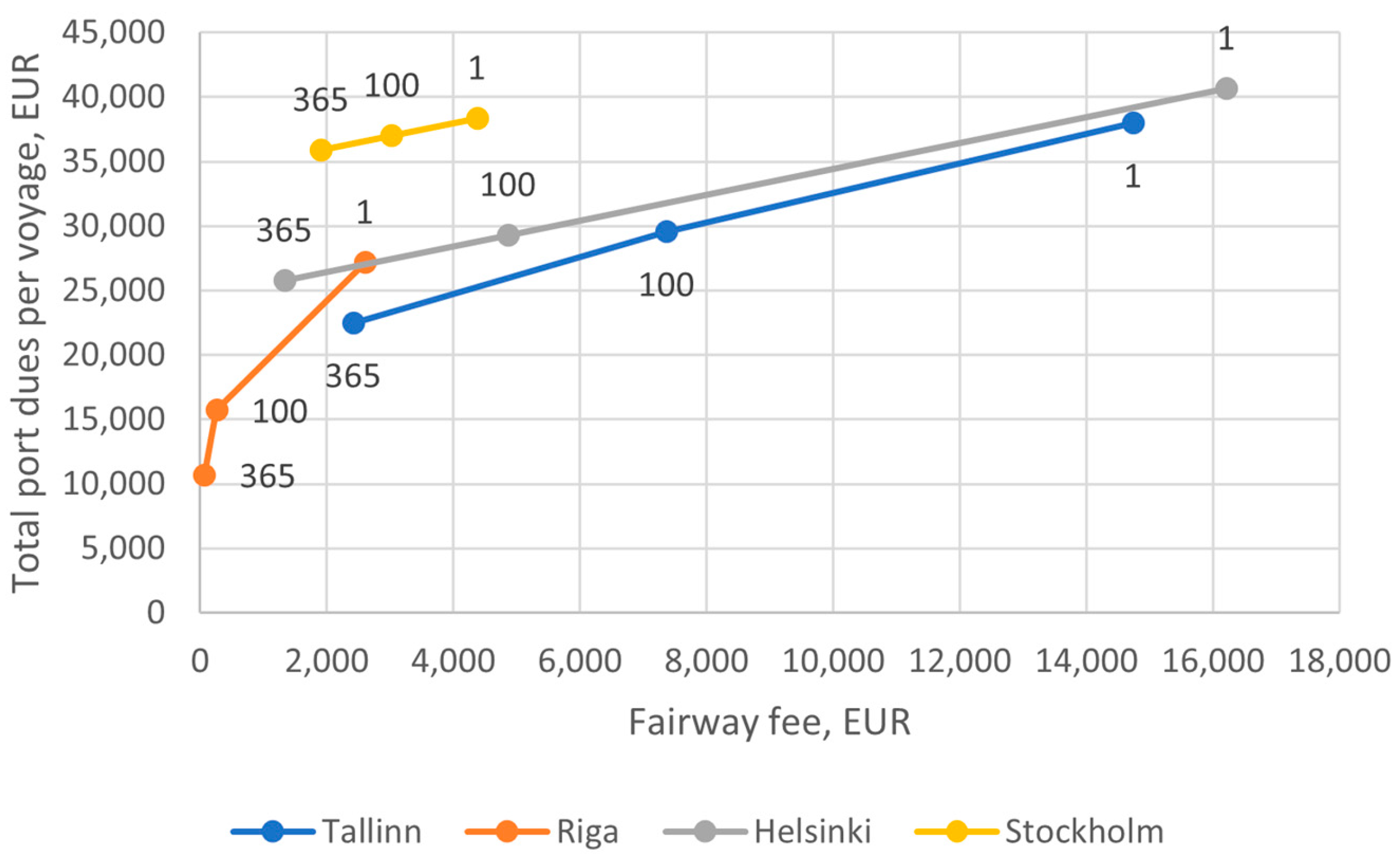

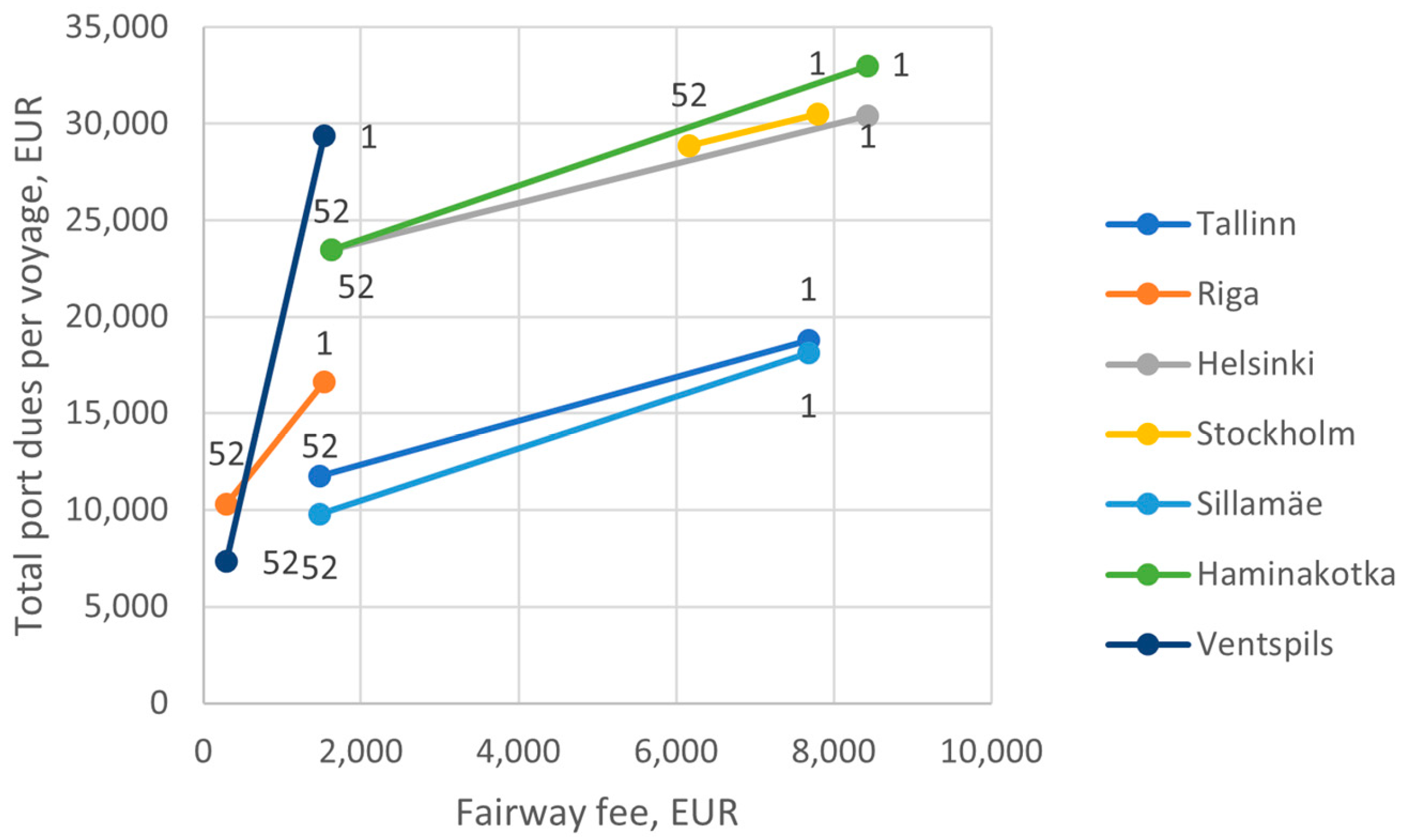
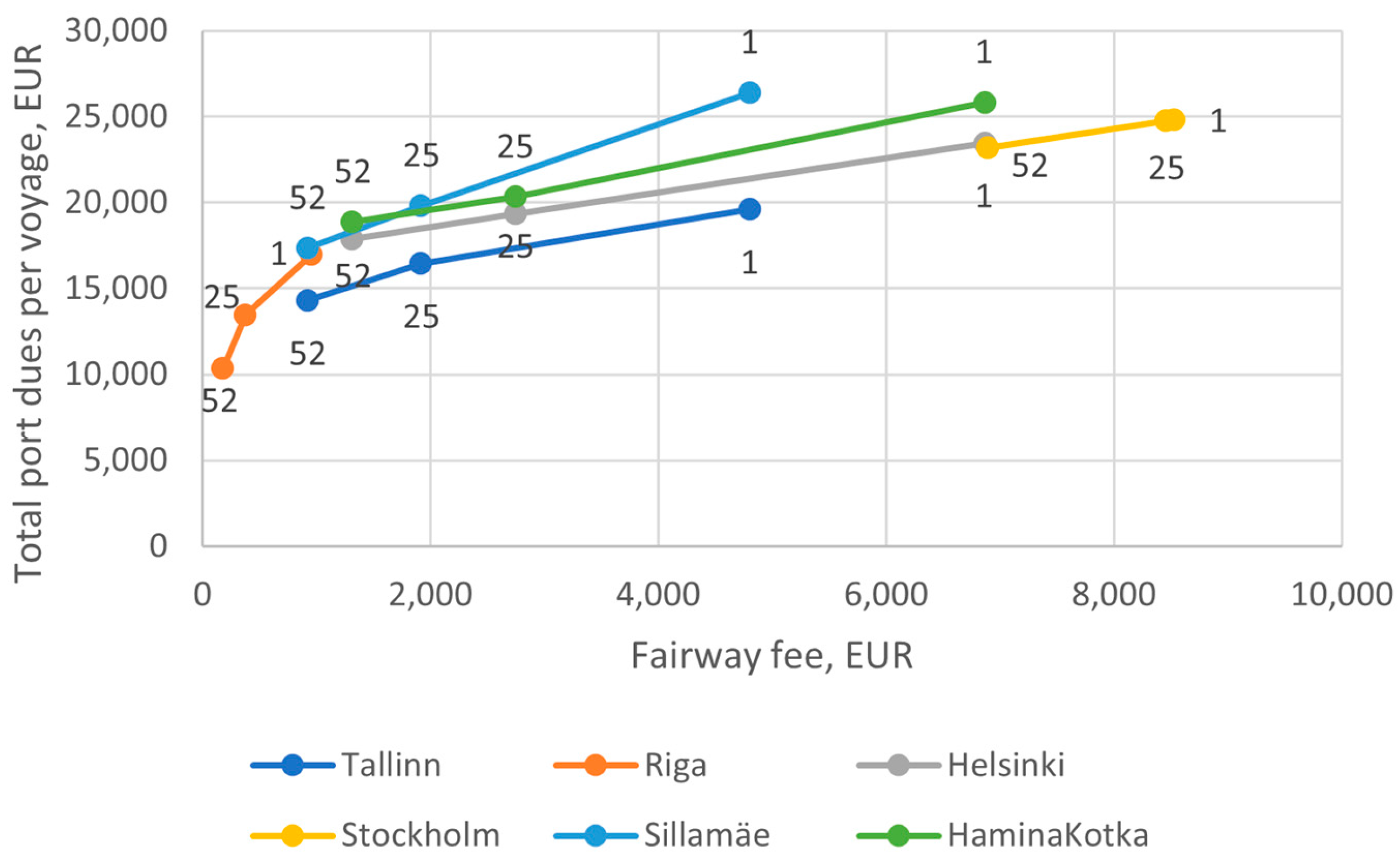
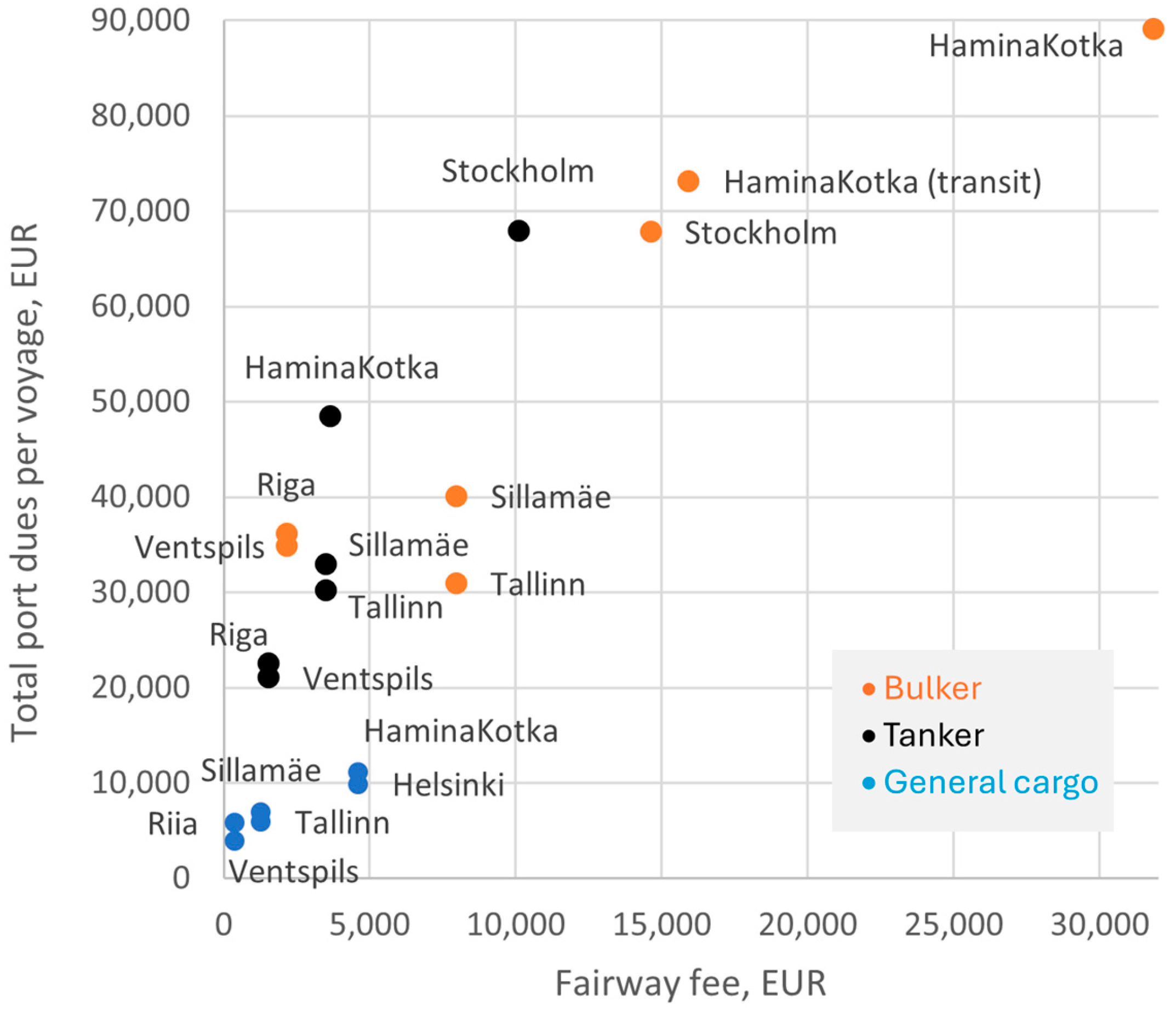
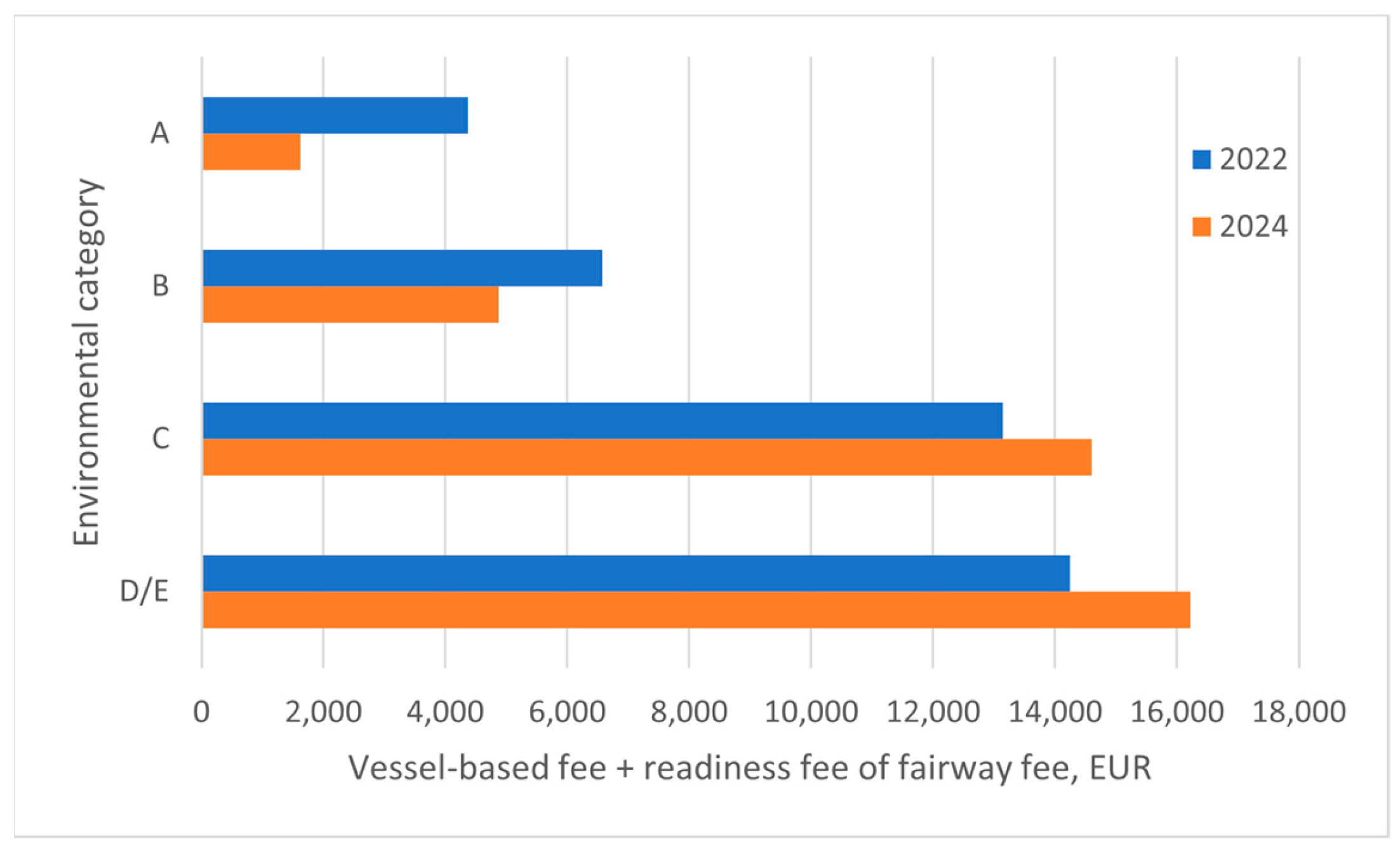
| Fee Type | Estonia | Latvia | Finland | Sweden | Alternative Term Used | |||
|---|---|---|---|---|---|---|---|---|
| Tallinn | Sillamäe | Riga | Ventspils | Helsinki | Hamina Kotka | Stockholm | ||
| Vessel fee | GT, vessel type | GT, vessel type | GT, vessel type | NT cargo or passenger vessel | NT cargo or passenger vessel | GT | tonnage fee; vessel charge | |
| Canal fee | GT, vessel type | GT | ||||||
| Berth(ing) fee | GT, vessel type | GT | ||||||
| Waste management charges | GT, vessel type | GT, vessel type | GT, vessel type | Vessel type, GT, staying time span | NT, cargo or passenger vessel | NT, cargo or passenger vessel | Fixed, GT, m3, ton | waste fee; sanitary fee; solid waste + sewage + oil-containing waste originating from engine room |
| Mooring and unmooring charges | Per operation, GT range | Per operation, GT range, vessel type | Per operation, GT range | Per operation, GT range | Per operation, NT range | Per operation, NT range | Per operation, vessel length, time | |
| Passenger fee | Passenger | Passenger | Passenger | Passenger | Passenger | Passenger | passenger | |
| Cargo charge | Cargo unit * | Cargo unit/ton | Cargo unit/ton | Cargo unit/ton/lm | * vehicle cargo charge | |||
| Pilotage charge | GT range, pilotage in port + distance 1 | GT range, pilotage in port + distance 1 | GT, operation, (+ distance on sea if needed) | NT range, base fee + distance 3 | NT range, base fee + distance 3 | NT range, base fee + distance 2 | ||
| Fairway fee | GT, ice-class 2 | GT, ice-class 2 | GT, vessel type 2 | GT, vessel type 2 | NT, ice-class, amount of cargo 4 | NT, ice-class, amount of cargo 4 | NT range, vessel’s environmental category, goods/passengers 2 | fairway due, waterway fee/due, navigation fee/due |
| General Cargo Vessel | Container Vessel | Tanker | Bulker | Ro-ro Vessel | Cruise Vessel | Passenger Ferry | |
|---|---|---|---|---|---|---|---|
| Length, m | 100.71 | 170.02 | 169.5 | 187 | 187.06 | 293.2 | 212 |
| GT | 3610 | 16,023 | 15,980 | 22,746 | 25,609 | 99,526 | 49,134 |
| RGT | 12,748 | ||||||
| NT | 1783 | 6251 | 7777 | 12,344 | 7682 | 63,078 | 15,621 |
| DWT | 5164 | 20,073 | 25,117 | 36,746 | 11,702 | 7900 | 6080 |
| TEU | 1440 | 156 | |||||
| Passengers | 2506 | 2800 | |||||
| Ro-ro capacity, lm | 3322 | 3653 | |||||
| Ice-class * | 1C | 1A | 1A Super | 1C | 1A | --- | 1A |
Disclaimer/Publisher’s Note: The statements, opinions and data contained in all publications are solely those of the individual author(s) and contributor(s) and not of MDPI and/or the editor(s). MDPI and/or the editor(s) disclaim responsibility for any injury to people or property resulting from any ideas, methods, instructions or products referred to in the content. |
© 2025 by the authors. Licensee MDPI, Basel, Switzerland. This article is an open access article distributed under the terms and conditions of the Creative Commons Attribution (CC BY) license (https://creativecommons.org/licenses/by/4.0/).
Share and Cite
Hunt, T.; Tapaninen, U.; Kotta, J. Differences in Port Pricing Strategies: Case of Port and Fairway Fees in Northern Baltic Sea Countries. Sustainability 2025, 17, 3275. https://doi.org/10.3390/su17073275
Hunt T, Tapaninen U, Kotta J. Differences in Port Pricing Strategies: Case of Port and Fairway Fees in Northern Baltic Sea Countries. Sustainability. 2025; 17(7):3275. https://doi.org/10.3390/su17073275
Chicago/Turabian StyleHunt, Tõnis, Ulla Tapaninen, and Jonne Kotta. 2025. "Differences in Port Pricing Strategies: Case of Port and Fairway Fees in Northern Baltic Sea Countries" Sustainability 17, no. 7: 3275. https://doi.org/10.3390/su17073275
APA StyleHunt, T., Tapaninen, U., & Kotta, J. (2025). Differences in Port Pricing Strategies: Case of Port and Fairway Fees in Northern Baltic Sea Countries. Sustainability, 17(7), 3275. https://doi.org/10.3390/su17073275









